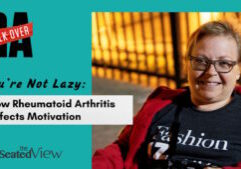Dead from the Waist Down
The other day, I meandered into the clinic for my shot and had a chat with one of the nurses. Specifically, I had a chat regarding the examination tables in the clinic. Not that they are any different than examination clinic in any other doctor’s office or hospital in the city. In fact, I didn’t know there was an alternative to the 5-mile high fixed table o’ torture until I for a mysterious administrative reason had to sign in at the MS clinic across the hall for an appointment with my rheumatologist. In there, all the examination tables were adjustable! Blew my mind. Anyway, just as you send your car (or wheelchair) in for annual maintenance, it’s a good idea to take your body in for a check-up and this involves a Pap test. Not that I want a Pap test – I’ve yet to meet a woman who thinks that particular medical procedure is a hoot – but it’s generally a good idea. Except for the inaccessibility of the 5-mile high fixed table o’ torture to someone with extreme pain issues.
The clinic where my family doctor’s at has a higher-than-average number of patients who use wheelchairs, as this neighbourhood is very accessible. After the nurse had given me the number for the person in charge of equipment buying and we’d exchanged a mutual (and cynical) “probably not in the budget” sigh, I asked her what the clinic did for those patients who for one reason or another were required to be in a reclining position. When they could, people would be lifted up onto the table. Or if they had a tilt on their wheelchair, an internal exam would be done in the chair, with additional clinic staff holding the person’s legs to provide access for the doctor (lovely mental image, that). I opined that although having an internal exam is not the most dignified of events, this seemed excessively undignified. Then the nurse mentioned that they used to have a trauma chair that could be repositioned into a bed-like thing, but this contraption had been taken away when the storage room was made into an additional exam room, “so they could serve more people”. As the nurse is not the person making these decisions, I chose at this point to bite my tongue around the statement that expanding their practice had essentially served to block a percentage of their patients from having equal access to medical care. I then asked what they did if the person, for weight, pain, spasticity or other reasons, couldn’t be tossed around like a sack of potatoes or didn’t have a tilt on their chair and she told me that such patients were sent to The Anne Johnston Health Station. The only barrier-free clinic in a city of 5 million people. 15% of the population has a disability. Miscellaneous impairments are on the rise with the aging babyboomers. An adjustable table would serve all patients – not just people with miscellaneous impairments – and this is yet another example of how barrier-free design benefits everyone. It’s called universal access. I wish more places would think about that.
But barrier-free design is not the issue of today’s rant. Barrier-free thinking is.
I’m 45 years old, have had a chronic disease since I was 4 and used a wheelchair since I was 16. In my entire life, I have yet to have a doctor initiate a conversation regarding my crotchal area, maintenance of same, sexuality, contraception and whatever else you can think of related to that part of the body. When I was about to start methotrexate almost a decade ago, I did my research (as usual – I’m pretty sure many doctors find it annoying that I do research and have questions, but I’m not here to make their life easier, it’s the other way around). I had agreed to start the medication and my doctor went through possible side effects with me and was making the final notes in the chart, wrapping up the appointment, when I piped up and asked about how the drug causes birth defects. She froze for a second, looked up with an utterly gobsmacked expression on her face and asked “are you sexually active??”. Which in our culture isn’t an unusual thing to consider of a single woman in her 30s, right? Except, apparently, when the woman uses a wheelchair. A study in the US reveals that women with disabilities are underserved in reproductive health care. For instance, when women with disabilities visit an OB/GYN, they are 20% less likely to receive a Pap test than are able-bodied women.
From a brief excursion into Google, the guideline appears to be that all women who are/have been sexually active should have a Pap test every two years (until the age of 70, I guess because that’s when reproductive organs and sexuality disappear in a puff of smoke, but that’s a rant for another day). And there we have it, because the world prefers people with disabilities to be asexual and if you’re a woman with a disability, asexuality is practically a requirement. There’s a substantial ick factor with disability and chronic illness, which means that if you have a partner, s/he is automatically viewed either as saintly (because the relationship couldn’t be other than patient caregiver to the poor sick person) or creepy and perverted (because only someone who is disturbed could be attracted to the poor sick person). We with the disability are not considered at all – apparently the role of tragic cripple is incompatible with sexuality to the point that the genital/reproductive area is not just an empty space, but a non-space. It doesn’t exist.
The problem is that this preference for us to be potted plants – come to think of it, plants are probably allowed more action than we are – affects not just the ability to refrain from staring when a couple is holding hands in public or gushing messily about how saintly a partner is. The problem is that it affects health care delivery. Imagine what would happen if people with disabilities were recognized as sexual beings, too. Imagine what would happen if, amid all the programs for physical and social rehabilitation, there were some for sexual education. Which might include talking about what to do in case of abuse (because lord knows, that’s not covered anywhere else). There’s an insane rate of abuse, sexual and otherwise, in the disabled community – one study reports that 40% of women with physical disabilities report being sexually assaulted. Or such initiatives could talk about ways to facilitate a healthy sex life and provide information regarding alternate ways of having sex, contraception and how to get your doctor over the ick factor and ask for a Pap test.
Of course, that would involve doctors buying adjustable examination tables and that, apparently, is not in the budget.
Late note: Haloscan appears to be down AGAIN. If you wanted to leave a comment, please check back – I hope the problem will be resolved soon. I will be spending some time re-thinking commenting in this space.
Tag:
Read More
Discover what else I've been writing about...















